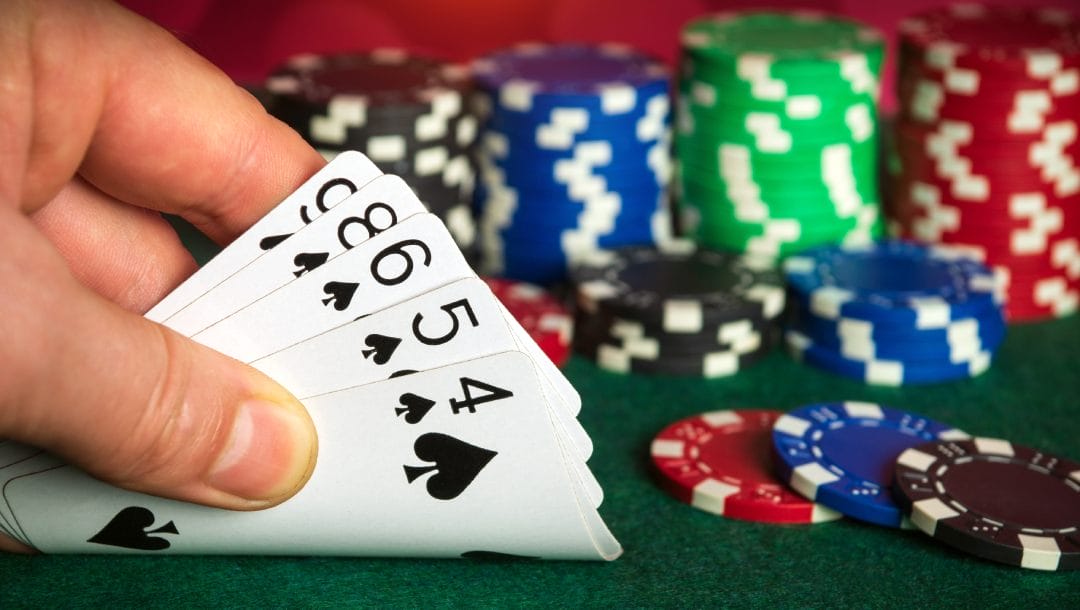New to poker and unsure of what a flush draw is? Find out what it is, how strong a hand it is and when to play it.
What Is a Flush Draw in Poker?

Every online poker player learning how to play poker needs to understand the basic fundamental theorem of poker that drives habitual winners. Whether you’re a strategic small micro-stakes poker player or a regular at online poker games, you need to be able to gauge whether your hand is strong enough to take the pot.
As David Sklansky wrote in his 1978 book, The Theory of Poker: “Every time you play a hand differently from the way you would have played it if you could see all your opponents’ cards, they gain; and every time you play your hand the same way you would have played it if you could see all their cards, they lose.”
Simply put, building your hand is always informed by how much information you can extract from the game and your opponents. This applies in every instance. Today, we look at it in the context of a flush draw.
A draw or drawing hand simply refers to when you are one card away from a valuable hand that increases your probability of winning the pot.
One of the more valuable hands is, of course, a flush – understood as any five cards from the same suit. A flush draw simply refers to when you’re only one card away from holding a flush.
Let’s dive into what constitutes a flush draw, how it is played and whether it represents a strong tactic to use.
Types of flush draws
Four flush
A typical flush draw assumes that you have four cards of the same suit in your hand and only need one more to complete a flush. When you have four of the same suit in your hand regardless of when you draw them, it is sometimes referred to as a four flush.
Backdoor flush draw
When you play poker online, you’re most likely playing Texas Hold’em or Omaha where there are community cards. In these formats, it is possible that you will receive three cards of the same suit at the flop. This gives you opportunities to complete a flush at both the turn and the river. This is known as a backdoor flush draw.
How strong is a flush draw?

Many recreational players who play poker online games are immediately excited by the prospect of a flush draw regardless of the strength of their cards. As soon as they see three or four cards of the same suit, they assume they are on to a winning hand.
However, it is important to know that not every flush draw will be the highest-ranking hand even when it is completed. Especially when you consider that a flush is only the fifth highest-ranking hand in poker.
This means that even if you complete your flush, you still run the risk of being beaten by a full house, four of a kind, a straight flush or a royal flush.
Flush rankings
Flushes are ranked by the value of the highest card followed by the second highest and so on. If you have low cards in your flush draw, it is probably not a good idea to pursue it as your opponents may very well complete a higher-ranking flush than you.
Better hands
Considering that a flush is only ranked fifth highest, you also need to assess whether others run the possibility of better hands based on the community cards available.
For instance, if you are holding a backdoor flush draw with high-ranking cards, but there is a pair of tens at the turn on the table, there is a strong possibility that an opponent may have a full house.
Be aware of what’s on the table before you bet aggressively unless, of course, you’re heading towards a straight or royal flush.
What are the odds of completing a flush draw?
This is where it gets interesting. If you’re a regular at Texas Hold’em or Omaha online poker tournaments, you will know that the probability of a flush (excluding straight or royal flushes) is around 3%.
A flush draw, on the other hand, is far more probable. Assuming you draw two suited hole cards like a pair of spades or diamonds pre-flop, the probability of hitting a flush draw at the flop is around 10.9%.
Should you get the flush draw at the flop, the probability of completing it goes up to 19.1% at the turn and 19.6% at the river.
Another way to calculate your probability is to count the outs. Outs are cards that are likely to give you the advantage depending on the hand you’re trying to build. Should you have a flush draw then you know that there are nine outs (the remaining cards in the suit you’re building.)
A rule of thumb to assess the probability of completing the flush on the turn is to multiply the outs by two i.e. 9 X 2 = 18%. That doubles on the river.
When to pursue a flush draw
Implied odds
Implied odds refer to the potential amount of money you could win based on a number of factors including, but not limited to, the size of your opponent’s stack, the skill level of your opponent and super aggressive opponents.
When faced with any of the above, playing a flush draw to possible completion has a high probability of winning. However, you have to be on your toes.
Calculating your implied odds can be tricky and requires some skill if you’re playing online poker for real money.
For instance, if only one of your hole cards forms part of the flush draw, then the other three are on the table. This means there is a high probability that your opponents are holding the same or better than you, in which case, they may have already completed their flush.
Your implied odds in this instance are low. Understanding this can save your stack.

Aggression
If you’re confident of your chances based on your flush draw then aggression is a tactic to scare your opponents into folding before the river. Especially if they are recreational or risk-averse players.
By re-raising, you can thin the herd, knowing that your flush draw has a high probability of completion and, if you’ve done your calculations well enough, you can see off stubborn opponents.
Defence against a call
Should an opponent survive your re-raise and call, you need to go into serious assessment mode. At this point, you will have to get a little more granular in checking your odds before deciding on your next course of action.
Let’s say you didn’t complete your flush at the turn. You know that there is still an 18% chance of completing it at the river based on the outs. Revisit your earlier assessments.
How do you rank your flush draw? Is there a pair on the table?
Based on your calculations, your best action is to check at the turn and see what happens at the river given you still have a chance of completing your flush.
Should the opponents re-raise, then you will need to assess your appetite for risk relative to all the calculations you’ve made up to that point and decide whether to call, fold or raise.
To flush or not
Flush draws in general can be a rookie’s Achilles heel. At first glance, it appears that you are onto a winning hand and this can drive a false sense of security.
To genuinely play a flush draw, you need to have a good grasp of Texas Hold’em poker rules, read the table and assess your opponents beyond just a blind bluff. Take time to work out the probabilities and examine your opponents’ tactical nous before blindly trying to complete your flush.
BetMGM is the royal flush of online poker
Register with BetMGM to test your new-found poker prowess. And when you’re done with poker, try out the host of other exciting online casino games from online slots to blackjack.


